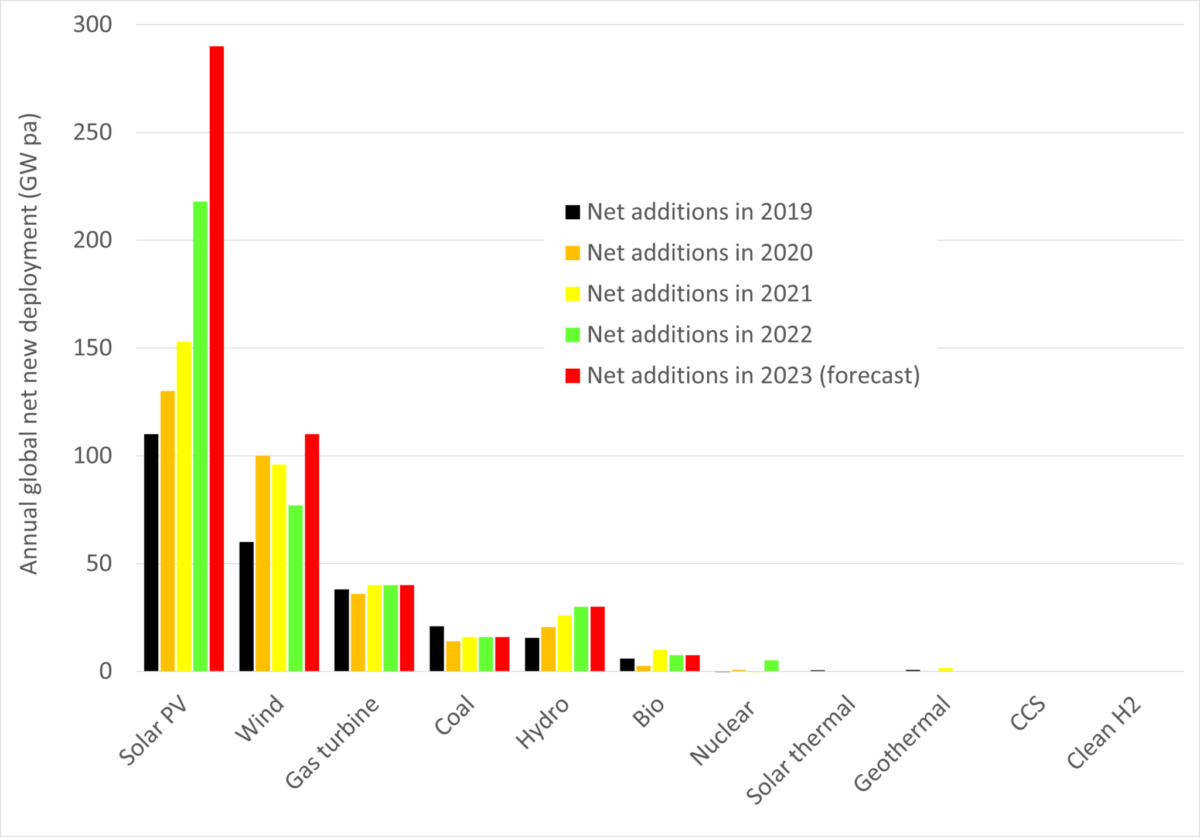The fastest energy change in history is underway. New solar PV generation capacity is being deployed faster than everything else put together. The price of PV continues to fall, and PV is essentially unconstrained. Thus, solar PV is growing to dominate not just electricity production, but also all forms of energy production, via the electrification of nearly everything.
How much waste?
Typical electricity consumption in advanced economies is 7-12 MWh per person per year. This will need to double to accommodate the electrification of transport, heating and industry. In some countries, additional electricity will be required to decarbonize the chemical industry: metals, ammonia, plastics, synthetic jet fuel, etc. Most of this electricity will come from solar, with limited support from wind and hydro.
For illustrative purposes, we can take an average per capita solar electricity generation of 20 MWh per year in an affluent fully decarbonized country. Assuming a typical DC capacity factor of 16% (rooftop and ground-mounted), then each person needs 15 kW of solar panels with an area of about 70 m2.
The panel lifetime is 20-30 years, and so about 3 m2 of solar panel waste per person per year is generated, with a mass of about 30 kg. This is small compared with the solid municipal waste stream in the USA of about 900 kg per person per year, and very small compared with CO2-equivalent emissions in the USA of 19,000 kg per person per year.
How much of the PV modules is recycled?
The aluminum frame and electrical cables of retiring solar panels are normally recovered because of their value.
Most of the rest of the panel is glass, which is not toxic and the raw materials of which are inexhaustible. The mass of glass in 3 m2 of solar panel is about 20 kg. This compares with the current US glass waste stream of 30 kg per person per year. Thus, if entirely discarded as landfill, solar panels would increase the glass waste stream, by two thirds, which is significant but far from overwhelming. The high quality of discarded low-iron solar glass may find specialist applications, including as starting material for new generations of solar panels, and in the road sign paint industry.
The solar panels also contain about 1.2 kg of silicon which is a non-toxic and extremely abundant material (n. 2 in the Earth’s crust). The balance of the panel comprises thin layers of protective plastic and a small mass of conductive metals such as copper (Cu), aluminum (Al) and silver (Ag) that may be recovered and recycled, depending on sufficient volumes to justify investments in recycling equipment.
A growing market in developing countries is the reuse, or second life, of solar panels. Many utility-scale solar power plants are replacing their 15% efficient panels with 22% efficient bifacial double-glass panels. The same trucks that deliver the new panels take back the retiring panels, which are then sorted and sent for a second life in low-power applications elsewhere.
During the early growth of an industry, the logistics to deal with retiring products might not initially keep up. This currently applies to both lithium batteries and solar panels. However, the pace of adoption of both technologies means that this will change quickly. The mature lead-acid battery industry provides a good example of high collection rates.
As the PV industry grows and matures, businesses will develop for sustainably managing end-of-life solar panels. The amount of PV materials to be recycled will remain comfortably below existing waste and recycling streams and hence no special disposal and recycling technology or logistics is required. Managing retiring solar panels will not be a limitation on the replacement of fossil fuels by solar.
How much avoided CO2?
Importantly, the 3 m2 of solar panels per person that is recycled each year has generated 20 MWh of electricity over its lifetime and displaced 20 tonnes of CO2 emissions. This is about 1000 times larger than the waste in the panels, and its avoidance is a spectacular environmental gain.
The waste stream of a wind turbine is similarly small compared with the CO2 displaced during its lifetime. Images of retiring turbine blades and solar panels being buried that periodically circulate on the web in shock articles fail to point out the 1000 larger mass of CO2 emissions that the turbines and panels have avoided.
Authors: Prof. Andrew Blakers /ANU) & Prof. Ricardo Rüther (UFSC).
Andrew.blakers@anu.edu.au and rruther@gmail.com
ISES, the International Solar Energy Society is a UN-accredited membership NGO founded in 1954 working towards a world with 100% renewable energy for all, used efficiently and wisely.
The views and opinions expressed in this article are the author’s own, and do not necessarily reflect those held by pv magazine.
This content is protected by copyright and may not be reused. If you want to cooperate with us and would like to reuse some of our content, please contact: editors@pv-magazine.com.








By submitting this form you agree to pv magazine using your data for the purposes of publishing your comment.
Your personal data will only be disclosed or otherwise transmitted to third parties for the purposes of spam filtering or if this is necessary for technical maintenance of the website. Any other transfer to third parties will not take place unless this is justified on the basis of applicable data protection regulations or if pv magazine is legally obliged to do so.
You may revoke this consent at any time with effect for the future, in which case your personal data will be deleted immediately. Otherwise, your data will be deleted if pv magazine has processed your request or the purpose of data storage is fulfilled.
Further information on data privacy can be found in our Data Protection Policy.